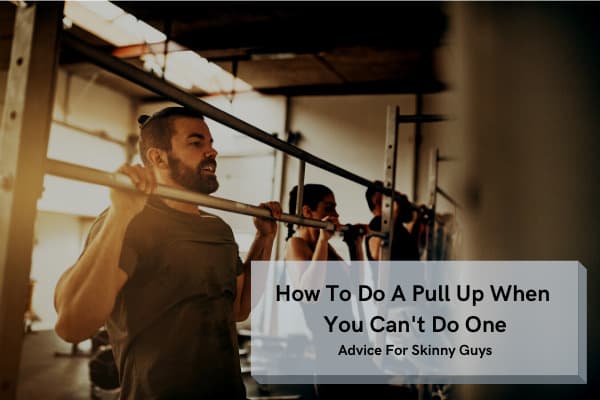Are you a skinny dude wondering how to do a pull-up when you can’t do one? Then read on! Because today I will be sharing advice on how to conquer this much-coveted exercise.
Doing a pull-up when you can’t currently do one requires you to increase upper body pulling strength to the point where you can complete a full pull-up. This can be achieved through exercises such as the assisted pull-up, negative pull-up, jumping pull-up, and half-pull-ups.
2 years ago I was that skinny dude baffled by the same problem. How the hell can I pull myself over that bar?! Through research and pure determination, I was able to complete my first pull up in 1 month! And today, I’ll be sharing tips on how you can do the same.
So get your pen and paper ready, and let’s dive right in.
Oh, be sure to read to the end for the Kalibre pull-up progression plan!
First, here are Rez Fitness’s top tips!
Secondly, here’s a summary infographic for the skinny dudes who want to skim ahead.
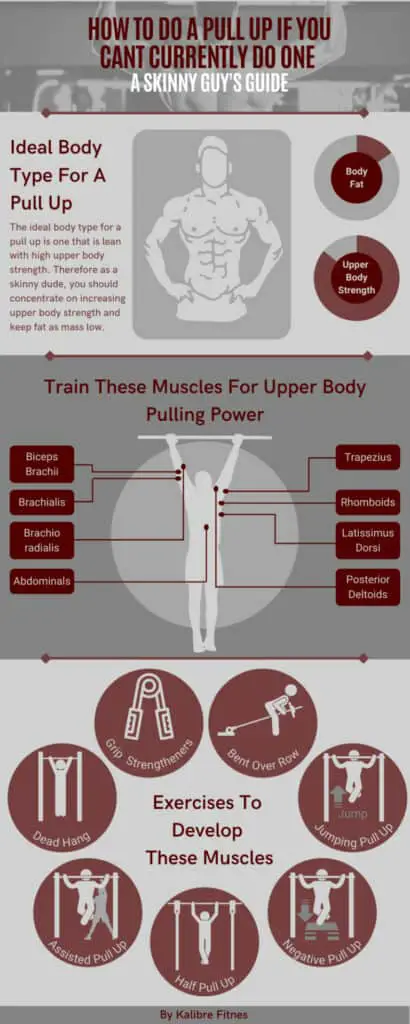
The Reason Why You Can’t Do A Pull Up
Before we begin, I need to set one thing straight- this exercise is HARD!
In fact- as a seasoned weight lifter myself, I can confidently say it’s one of the hardest exercises to do.
So don’t beat yourself up about it if you can’t do one.
Instead, follow the Kalibre pull up progression plan (more on that later)!
There are 3 main reasons why you are unable to do this exercise:
- Muscles lack strength.
- Joint and stabilizers are un-adapted
- Body type is not suitable
1. Muscles Lack Strength
Did you know that the pull up requires more than the arm muscles? In fact, the arms play only contribute to around half the force generated in this exercise (contrary to popular beginner belief).
Read my article to learn how to get stronger arms!
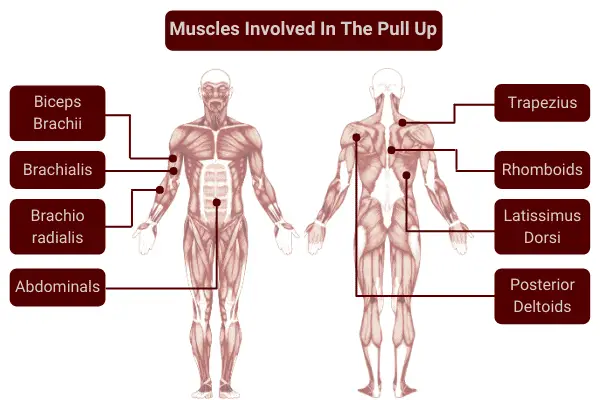
The bad news? If you cannot currently do this exercise, chances are one or more of these muscles are not yet strong enough! (Damn!)
The good news? There are a handful of simple exercises you can do to train all these muscles at the same time (more on that later)
2. Joint And stabilizers Are Un-Adapted
Have you ever tried to do a pull up, and it £#*#@%# hurts?
Well, that’s because the pull-up is a very intense exercise on the shoulder joint (which is a ball and socket joint).(3)

Think about it- your entire body mass is being concentrated onto the shoulder joint! Ouch.
Furthermore, the muscles holding the ball and socket together have not yet been strengthened. And this places even more stress on the shoulder joint.(4)
No wonder it hurts!
But the good news?
The exercises I describe later will help you strengthen those joints!
3. Body Type Is Unsuitable
Your body type is a major factor when it comes to your ability to complete this pulling exercise.
In fact, people who are lean and have a high relative upper body strength tend to be able to do pull-ups with ease.
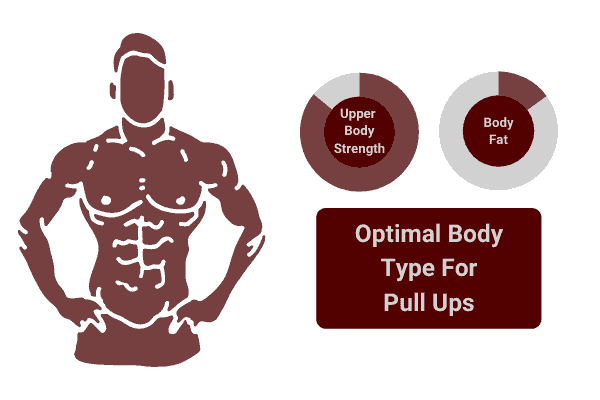
If you are a skinny dude reading this post, then chances are you are lean. But you may lack the required upper body strength.
But don’t worry- the exercises I describe later will build your upper body pulling strength in no time!
You can read my article to learn how to increase muscle size and strength!
Equipment Required To Learn How To Do A Pull Up
Before you learn how to do this exercise, you need to have the correct equipment.
Don’t panic!
All you really need is a stable horizontal bar and pure determination and grit.
Where can you access a stable horizontal bar?
If don’t currently have a gym membership, then you can always buy home pull-up bars cheaply from amazon.
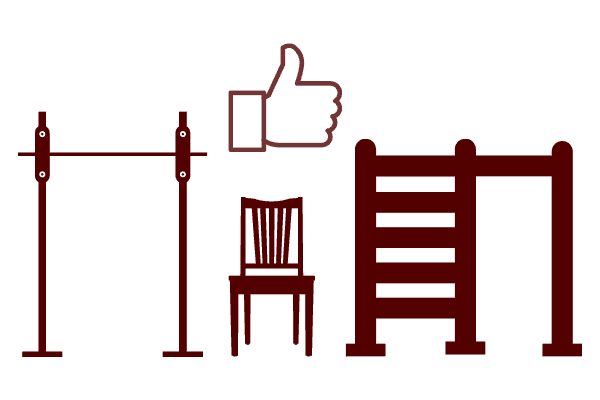
Additionally, many modern bars do not require the dreaded wall screws. You just hook on and use it.
Alternatively, many local parks have hanging bars you can use. And these are great for park workouts.
If you really want to get fancy- pull-up assist machines, resistance bands, and grip strengtheners will also help you to learn how to do a pull up.
Oh, a chair is helpful too (I will explain why later).
Do These Exercises When You Can’t Do A Pull Up
Many people can’t do pulling exercises because their bodies aren’t used to the movement pattern.
If you think about it- how often do you apply the strong pulling movement to your everyday life?
If you run obstacle courses or climb rocks every day, then ye maybe.
But for the rest of us, we rarely need to pull heavy weight (certainly not our body weight!) And this is why our muscles and joints are underdeveloped.
So here is a list of exercises that will turn you into a mean pulling machine:
1. Dead Hangs
This is an extremely basic yet effective exercise.
Simply find a bar and hang on it with a shoulder-width overhand grip.
Keeping your shoulder blades contracted will help ease the stress on your shoulders. This is because some of your body weight is unloaded to your back muscles.
Mastering the dead hang will provide a strong foundation for you to build into a pull up.
The dead hang will train your grip strength, forearm muscles (brachioradialis), shoulder muscles (posterior deltoids), and back muscles (trapezius, rhomboids, latissmus dorsi).
2. Grip Strengtheners
These are simple devices that you can pick up online.
Their simplicity and convenience make them an awesome tool in your journey to master the pull up. You can take them anywhere!
Grip strengthens will train your brachioradialis and overall grip strength. And this will help your dead hang.
3. Assisted Pull Ups
This exercise is exactly what the name implies!
They are pull ups where the upward motion is physically assisted by an external force.
This force can be applied by:
- Assisted pull up machines- kneel down on the platform and let it help push your body upwards.
- Resistance bands- tie a band to the bar, make a loop, and step into the loop. Using high-tension bands will provide maximum assistance.
- Spotter- have a friend push on the small of your back whilst you pull.
Applying assistance is a great way to engage all the muscles used in the pull up. So this makes them great for beginners.
But for maximum results, you should combine assisted pull ups with the other un-assisted exercises described.
4. Negative Pull Up
This exercise concentrates exclusively on the downward phase of the pull up.
In other words- you are focusing on lowering your body from the bar rather than raising your body towards the bar.
First, get your chair (the one I recommended you get before remember?). Then grab the bar at chin level with a shoulder-width overhand grip, and lower yourself as slowly as possible. Now repeat for reps.
This exercise is an essential way to build up to a normal pull up.
This is because they work your all arm, back, and shoulder muscles in an eccentric manner. And eccentric training is the best way to develop muscle size and strength!(5)
5. Jumping Pull Ups
This is a form of assisted pull-up.
The difference?
You are assisting yourself!
Approach a horizontal bar and jump up to grab the bar. As you grab the bar, use the upward momentum generated by the jump to help you get your chin over the bar. Then lower yourself and repeat.
These are a great way to practice the upward pulling movement without the need for additional equipment or bothering your friends!
6. Half Pull Ups
This is a beginner-friendly upward-pulling exercise.
Approach this exercise like you would with a regular pull-up. But instead of allowing your arms to fully extend, you pull yourself up when the arms are half extended.
This reduces the range of motion and makes the movement a lot easier.
This exercise is a great way for beginners to build up the arm, shoulder, and back muscles.
Additionally, the reduced range of motion will put less stress on the shoulder joint!
7. Tangental Pulling Exercises
Tangental pulling exercises describe any exercise which requires you to flex your arms towards your torso.
These exercises will help you to build general upper-body pulling strength. And this is essential for skinny guys (who lack general body strength).
Resistance training is a great way to build upper-body pulling strength.
And if possible, I would highly advise you to perform rowing exercises. These can be done with free weights or resistance bands.
Alternatively- you can do chin-ups and horizontal pull ups.
Chin ups utilize a narrow underhand grip. And the change in grip makes this exercise much easier to perform for most people.
Horizontal pull ups require a low-hanging horizontal bar (use a racked barbell if you have one!).
Simply suspend your body at 45°, with your feet planted on the ground. Then pull your torso towards the bar.
All of these exercises are beginner-friendly pulling exercises. And this makes them awesome to train your arm, shoulder, and back muscles!
Kalibre Pull Up Progression Plan
Great. So now you know which exercises to practice.
But how can you incorporate them into a plan?
After all, following a plan is the best way to achieve a goal right?
I would like to introduce the Kalibre Pull Up Progression Plan!
Simply follow this 4-week training routine to become a mean pulling machine!
This routine can be incorporated into your regular weightlifting program (if you have one).
Read my article to learn how to choose a suitable weight for weight lifting exercises!
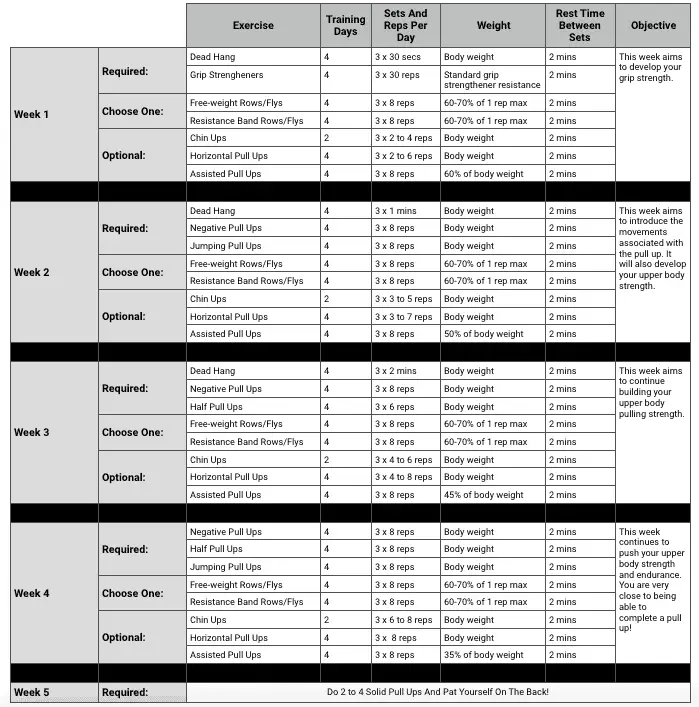
Time To Do The Pull Up!
Awesome. Now you are ready to do a pull up!

Here are some tips and pointers to help you “pull it off” (get it?):
- Jump up and grab the bar with an over-hand grip- your grip should be slightly wider than shoulder-width apart. Wrap your fingers over and thumb under the bar.
- Engage your core and shoulders- the abdominal muscles should be tense. This will keep your body still. The shoulders should be pulled back. (squeeze your shoulder blades together). This will engage your back muscles and shift your weight from your shoulder joint.
- Squeeze the bar- increase your grip strength on the bar. This will allow all your upper body strength to be applied to the pulling movement next.
- Haul yourself up- Use your arms to raise yourself vertically upwards. Aim to bring your elbows towards your back. Keep your shoulder blades retracted to stop yourself from swinging. concentrate on your mind to muscle connection. This means you should actively engage your arm and back muscles as you drive upwards through.
- Pause at the top- you should hold the contraction when your chin reaches the bar. Once you are more comfortable with the exercise, aim to get your chin over the bar.
- Lower yourself down- hold the tension in your arms and back whilst lowering yourself down. This will prevent gravity from causing you to drop (which will not be good for the joints!)
Congratulations- you have just completed the pull up!
Conclusion
Finito!
Today, I have taught you how to do a pull up when you can’t do one.
More specifically, I have explained the reasons why you struggle with the pull up, provided 7 exercises that will improve your upper body pulling strength, shared the Kalibre pull up progression plan, and give you step-by-step instructions on performing the perfect pull up.
Many people struggle with this coveted exercise. Although skinny people have the advantage of low body fat (therefore reduced excess baggage), many still struggle.
But with good planning, determination, and grit, you can overcome this exercise and turn yourself into a mean pulling machine!
Has the Kalibre Pull Up Progression Plan given you the confidence to overcome your obstacles?
Feel free to send me a message if you have any questions! You can find my details on the “contact us” page.
You may also be interested in the downloadable Kalibre Blueprint PDF which details exactly how I gained 40lbs of lean muscle (it’s 100% free!). It details the exact exercises and nutrition (with printable worksheets) I used to go from skinny to ripped!
Thanks for reading guys!
Peace Out,
Kal
(Biochemistry BSc, Biomedical Sciences MSc, Ex-Skinny Guy)

